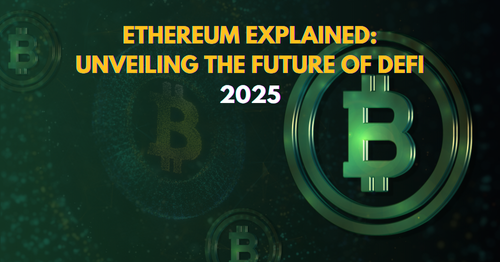Ethereum Explained: Unveiling the Future of DeFi. Ethereum is one of the most revolutionary blockchain technologies in existence. As the backbone of decentralized finance (DeFi), Ethereum is reshaping digital ownership and programmable money at an unprecedented scale. Its open nature, wide adoption, and innovative infrastructure make it a central pillar of the next-generation internet
What is Ethereum (ETH)?
Ethereum (ETH) coin is an open-source, blockchain-based platform that enables developers to build and deploy decentralized applications (dApps). Unlike Bitcoin, which is primarily a digital currency, Ethereum acts as a global decentralized computer that executes smart contracts. These are self-executing agreements with conditions written directly into code, removing the need for third-party enforcement.
Ethereum is designed to support a wide range of applications, from financial services to supply chain management and voting systems. Its native cryptocurrency, Ether (ETH), is used to pay for transaction fees and computational services on the network.
Owner and Establishment Year
Ethereum was conceived in late 2013 and officially launched on July 30, 2015. The platform was co-founded by a team of visionary developers including Vitalik Buterin, Gavin Wood, Anthony Di Iorio, Charles Hoskinson, Joseph Lubin, Amir Chetrit, and Mihai Alisie.
Among them, Vitalik Buterin remains the most recognized name and continues to actively lead research and development efforts for ETH. He is supported by a broader global community of developers and contributors focused on maintaining and evolving the ETH protocol.
History and Development
Ethereum began with a whitepaper written by Vitalik Buterin in 2013. The project raised over $18 million through a public token sale in 2014, making it one of the earliest successful blockchain fundraising efforts. Its first major software release, Frontier, went live in 2015, followed by several significant updates like Homestead, Metropolis, and Istanbul.
In 2022, ETH transitioned from the energy-intensive Proof-of-Work model to Proof-of-Stake (PoS) in an upgrade known as The Merge. This historic change drastically reduced Ethereum’s energy consumption and opened doors for future scalability improvements such as sharding, expected in upcoming phases.
Key Features and Underlying Technology
- Smart Contracts: Code-based contracts that execute automatically when predefined conditions are met.
- ETH Virtual Machine (EVM): A decentralized computing engine that powers the execution of smart contracts.
- Proof-of-Stake (PoS): A consensus mechanism that allows ETH holders to validate transactions and earn rewards, replacing energy-hungry mining.
- Layer 2 Scaling Solutions: Enhancements like rollups that improve speed and reduce transaction costs.
- Token Standards: ETH introduced widely adopted standards like ERC-20 for fungible tokens and ERC-721 for NFTs.
Ethereum’s architecture is modular and adaptable, making it suitable for various use cases beyond simple transactions.
Use Cases and Adoption
Ethereum has become the backbone for numerous industries embracing blockchain technology. Key areas of adoption include:
- DeFi (Decentralized Finance): Platforms like decentralized exchanges (DEXs), lending protocols, and stablecoins operate on Ethereum without central intermediaries.
- NFTs (Non-Fungible Tokens): ETH powers digital assets like artwork, collectibles, and music rights that are tokenized and traded globally.
- DAOs (Decentralized Autonomous Organizations): Community-driven organizations use ETH to manage operations and make collective decisions transparently.
- Gaming and Metaverse: Ethereum-based tokens and smart contracts power in-game economies and virtual real estate ownership.
Enterprises and startups alike are building on Ethereum to create decentralized apps with real-world value and reach.
Price Trends and Market Insights
Ethereum has experienced massive price volatility since its inception. From trading below $1 in its early days, it climbed to an all-time high of over $4,800 in November 2021. Although the price has seen corrections, ETH remains the second-largest cryptocurrency by market capitalization, right after Bitcoin.
Factors influencing Ethereum’s price include network upgrades, institutional adoption, NFT activity, and macroeconomic events. The shift to PoS and the anticipated scalability improvements are fueling long-term bullish sentiment. Market analysts view ETH as a long-term asset with growing utility in both speculative and real-world use cases.
How to Buy and Store Ethereum
Acquiring Ethereum is straightforward through any reputable cryptocurrency exchange. To buy Ethereum:
- Register on a trusted exchange.
- Complete identity verification (KYC).
- Deposit fiat money or another cryptocurrency.
- Purchase ETH and choose a storage method.
For storage, users can opt for:
- Hot Wallets: Apps like MetaMask and Trust Wallet for easy, everyday access.
- Cold Wallets: Hardware devices like Ledger and Trezor that keep your ETH offline and secure.
It’s essential to enable two-factor authentication (2FA), backup your seed phrases, and follow strong security practices to safeguard your assets.
Future Outlook and Predictions
The future of Ethereum looks exceptionally promising. With scalability solutions like sharding on the horizon, ETH aims to support thousands of transactions per second, making it more practical for mass adoption. The shift to Proof-of-Stake has already made it environmentally sustainable and economically efficient.
Developers are constantly improving user experience and transaction speeds with Layer 2 integrations, while governments and corporations explore Ethereum for enterprise use cases. Tokenized assets, identity verification systems, and decentralized social networks are just a few examples of where ETH could play a foundational role.
As the Web3 space matures, ETH is likely to remain a central force in driving digital transformation globally.
Conclusion
Ethereum is far more than a cryptocurrency; it is a global infrastructure enabling decentralization, transparency, and financial inclusion. With smart contracts, a vibrant developer ecosystem, and a future-focused roadmap, ETH stands out as one of the most impactful technologies of our time.
Whether you are a trader, investor, tech enthusiast, or developer, understanding ETH is key to grasping the full potential of blockchain technology.
For more insights and crypto analysis, stay tuned to our upcoming articles and educational resources on blockchain innovation.

I work as a content writer in the blockchain and cryptocurrency domain. I have a keen interest in exploring the world of digital assets, Web3, and emerging crypto technologies. My goal is to provide readers with easy-to-understand, engaging, and trustworthy insights, helping them stay informed and confident in the rapidly evolving world of crypto and blockchain.










